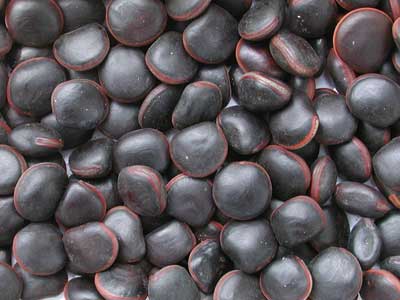| WWW.SEABEAN.COM HOME PAGE | Main UNIDENTIFIED page | E-MAIL Contact Info |
Unidentified Sea-Beans
 |
Dioclea ? Mucuna ? |
 |
|
I THINK that Dioclea spp. have VERY hairy stems & leaves, while Mucuna spp. will have only slightly hairy (or smooth) stems and leaves! This discussion needs to take priority, with data to back up statements, and this page needs to be revamped soon! When I sprouted one (thinking it was a Dioclea), a long time ago, it died shortly, HOWEVER, it did have lots of hair on the leaves. I didn't think much about it until Gwil Lewis (News and Notes, page 11 of The Drifting Seed Newsletter vol. 9(1) said: Dioclea has NO hairs, on leaves or the flower's calyx. Mucuna does have hairs. |
||
|
|
||
|
News and Notes | |
| Lately there has been some confusion about some of the seeds we find on the beach and have long referred to as "Diocleas." Both Izumi Hanno in Japan, and Mark Bartlett in Florida have been purchasing seeds; some look just like the non-spotted Diocleas we find on the beaches, but they are labeled Mucuna albertisii, and Mucuna benettii! Here's what Gwil Lewis from the Herbarium, Royal Botanic Gardens, Kew, had to say: "Dioclea and Mucuna are quite easy to tell apart in flower, all Mucunas have much larger flowers than all Diocleas. In foliage the 2 genera can be quite similar. In fruit it depends on the species. Some Diocleas and Mucunas have very similar seeds which are difficult to tell apart on gross morphology. Mucunas have irritant hairs on many parts, Diocleas do not. |  |
| Mucuna flowers often dry blackish, while fresh flowers range from white, through yellow to orange, red, purple, and green. Diocleas are nearly all pinkish, mauvish or purple and do not dry black, the standard (banner) often with a central yellow spot. The larger drift seeds of the two genera can look very similar." | |
 The brown specimen was uncommon, with most specimens dark brown to almost black. |
 Ed's specimens of the unknown species. |
 Dioclea reflexa Note the black spotting (Ed Perry's ID) |

This image (July 1, 2004) shows the growing tip of a leafless new sprout,
about 22 inches in total length and probably less than a week old.
The criteria are: Dioclea = NO hairs, on leaves or a flower's calyx; Mucuna: does have hairs.
Dioclea = MANY hairs; Mucuna = few hairs
Gwil Lewis states: "Mucunas have irritant hairs on many parts, Diocleas do not."
 Stem discontinuity, July 10, 2004. Growing tip and hairs to the top; base of stem and no hairs (or much fewer) to the bottom. |
 New leaves, July 10, 2004. They can't get much more hairy than this! This IS a Dioclea... see mature leaves, below. |
The following photos were taken July 25, 2004


o



The paired leaves of a Mucuna will have the midrib substantially offset from center.
Here's some photos of similar seeds


The specimens in the photo on the left were purchased on Ebay as "Bulls Eye Seeds", possibly from Central/South America.
The specimens in the photo on the right were purchased from a vendor in Tiliran, in the Guanacaste region of Costa Rica.
Click the images for a higher resolution view, then click the resultant image to really zoom in!